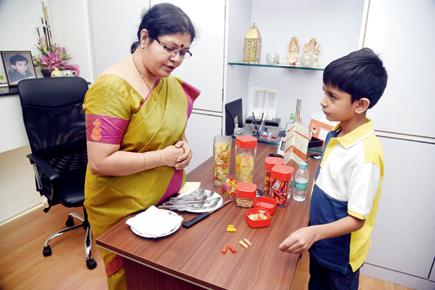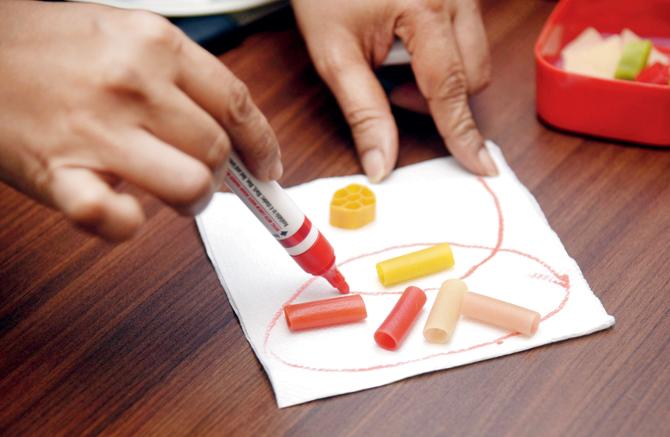Welcome to a class of Math In The Kitchen, where Raman demystifies a child's edgy relationship with numbers and shapes by using the kitchen as a laboratory


Bhuvaneshwari Raman with 8-year-old Rohan Udani. Pic/Sameerâu00c2u0080u00c2u0088Markande
ADVERTISEMENT
On a Thursday evening, when we drop by at KA EduAssociates, a Lower Parel-based educational management services company, we find Bhuvaneshwari Raman, a math and science specialist, busy arranging cutlery on the table. She then fills the bowl with colourful friams and cylindrical pastas, while placing the cheese slices on another plate. Closely observing her is a shy Rohan Udani, an eight-year-old from Fort's Cathedral and John Connon School.

Raman’s class on Venn diagrams
"Rohan, I want you to pick out all the cylindrical coloured pastas from the bowl," she instructs, adding, "Now, pick all the yellow pastas." Raman then draws two circles within an enclosing rectangle. "In one, we'll put pastas that are cylindrical and in the other, we'll put the yellow ones. But why is there something in between the two circles?" she throws a question at Udani. Without a moment's pause, he replies, because they are both cylindrical and yellow. "Absolutely right. So, the region in both circles, where the two sets overlap, is called the intersection of A and B." That was a session of Venn diagram.
Welcome to a class of Math In The Kitchen, where Raman demystifies a child's edgy relationship with numbers and shapes by using the kitchen as a laboratory. From tiny teaspoons to massive measuring cups, the kitchen is full of tools that can help take abstract mathematical concepts from the chalkboard to the dinner table. "When it comes to measurement, estimation, proportions, or even simple addition, subtraction, division or multiplication, cooking is a hands-on way to understand the subject. The kitchen will help you develop an appreciation for math as both fun and useful," she says.
Raman will launch the first session of Math in the Kitchen on January 28. The number of participants per class will be restricted to 30. "Children learn best when there's no fear, in an ambience where they feel it's okay to ask questions and make mistakes. You might have made a mistake with one cheese slice, but it's alright to ask for another," says Raman, vice-president of KA EduAssociates, established by award-winning educators, Fatima Agarkar and Gitika Kishanchandani. The training is usually offered to mothers and teachers who can teach the children in turn.
Using sphagetti, she teaches integer concepts and number lines, cheese slices are used for fractions and geometry, while bread is reserved for the Pythagorean theorem. It starts from pre-math concepts like sorting and patterns and goes on to trigonometry, statistics, probability and algebra upto the Class X level.
"Children learn tables by rote, but they don't understand it. So, sometimes, when I give a word problem, they ask me, 'is this division, addition, multiplication or subtraction'," she says. It's the translation of the word problem into what operation is required to resolve it, that Raman teaches. She uses something called the CPA approach (Concrete, Pictorial, Abstract) to develop a deep and sustainable understanding of maths. Developed by American psychologist, Jerome Bruner, this method, instead of the traditional method of teaching math, brings concepts to life by allowing children to experience and handle physical objects themselves.
Raman feels the reason for the fear of mathematics, which many like this writer harboured in their school days, is because we as students were never encouraged to ask questions. Another challenge, she says is algebra. "Till the 5th standard, you were taught numbers. Suddenly in the sixth grade, alphabets come into the picture, and the child is thrown off gear," she says. The key, here, is application of concepts in everyday life, points out the teacher. "It's all about logic. Rohan is in grade 2, but now he understands Venn diagrams which is taught in Class VI. How you approach a problem, is key," she smiles.
 Subscribe today by clicking the link and stay updated with the latest news!" Click here!
Subscribe today by clicking the link and stay updated with the latest news!" Click here!






